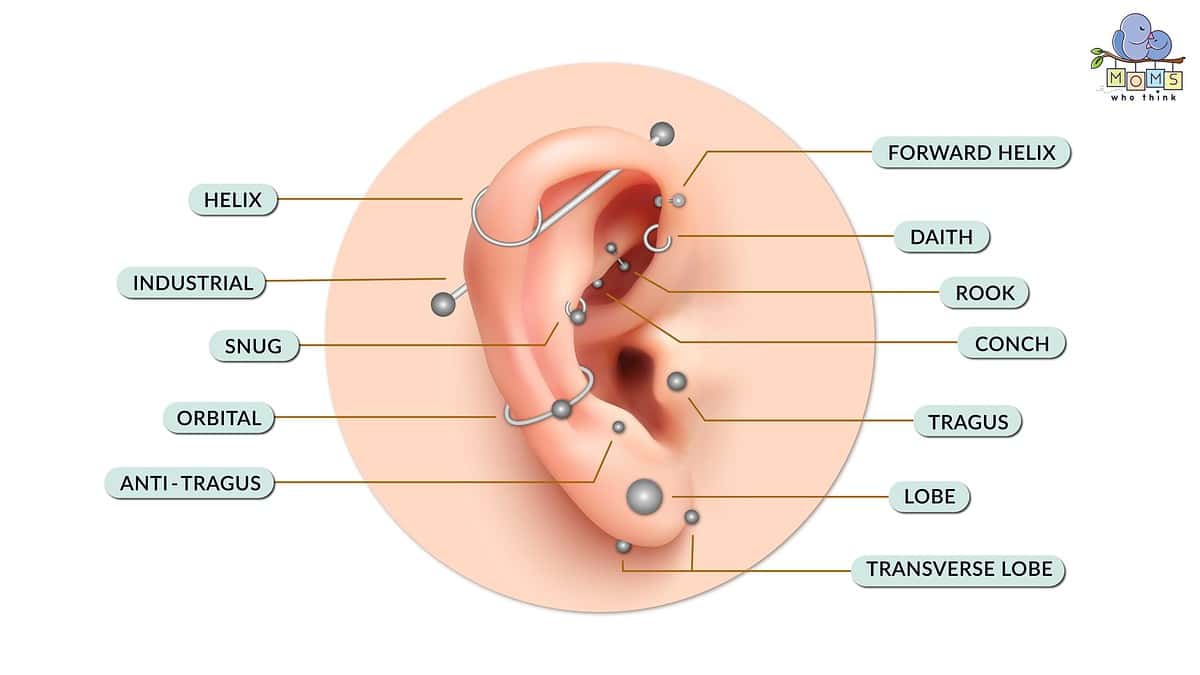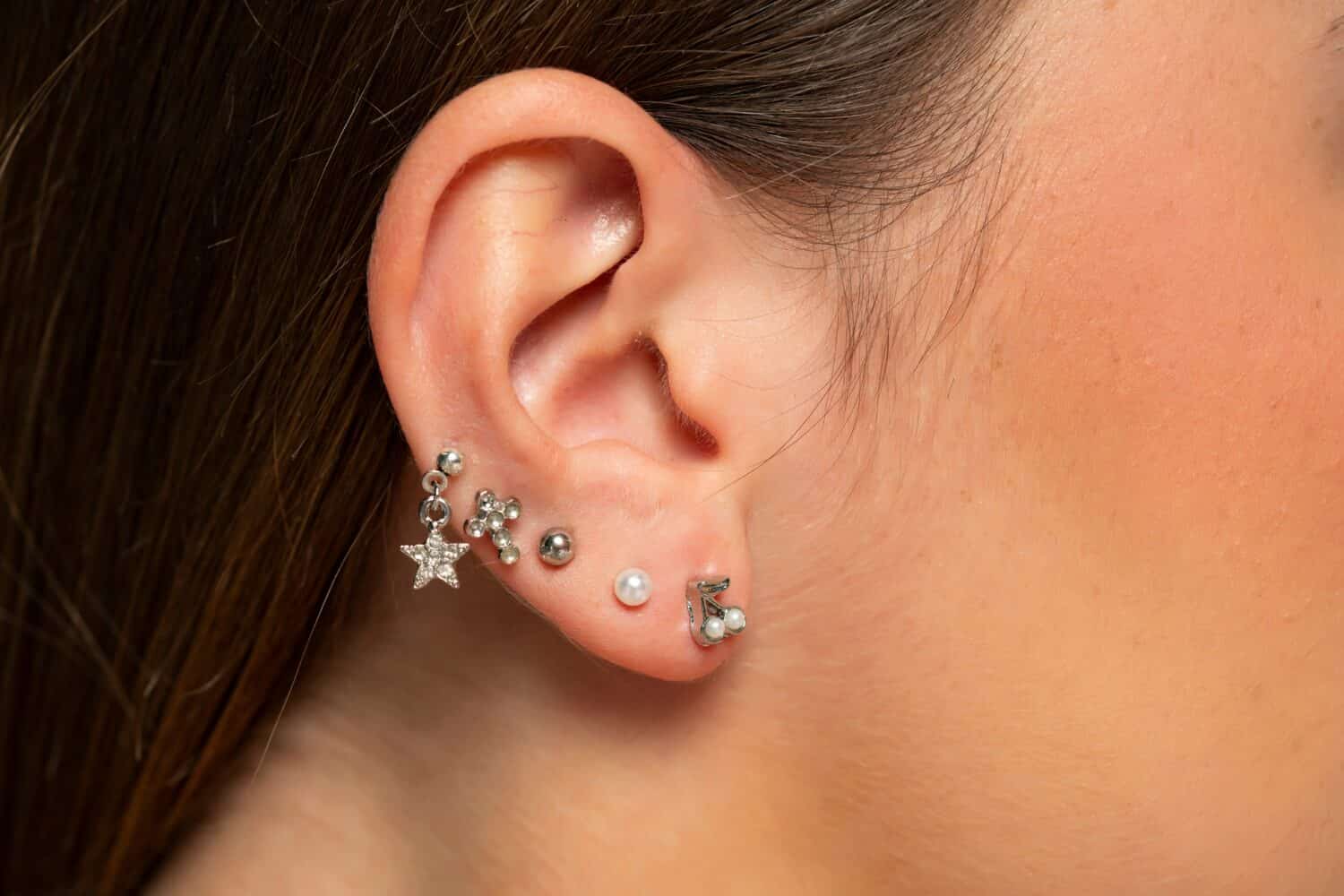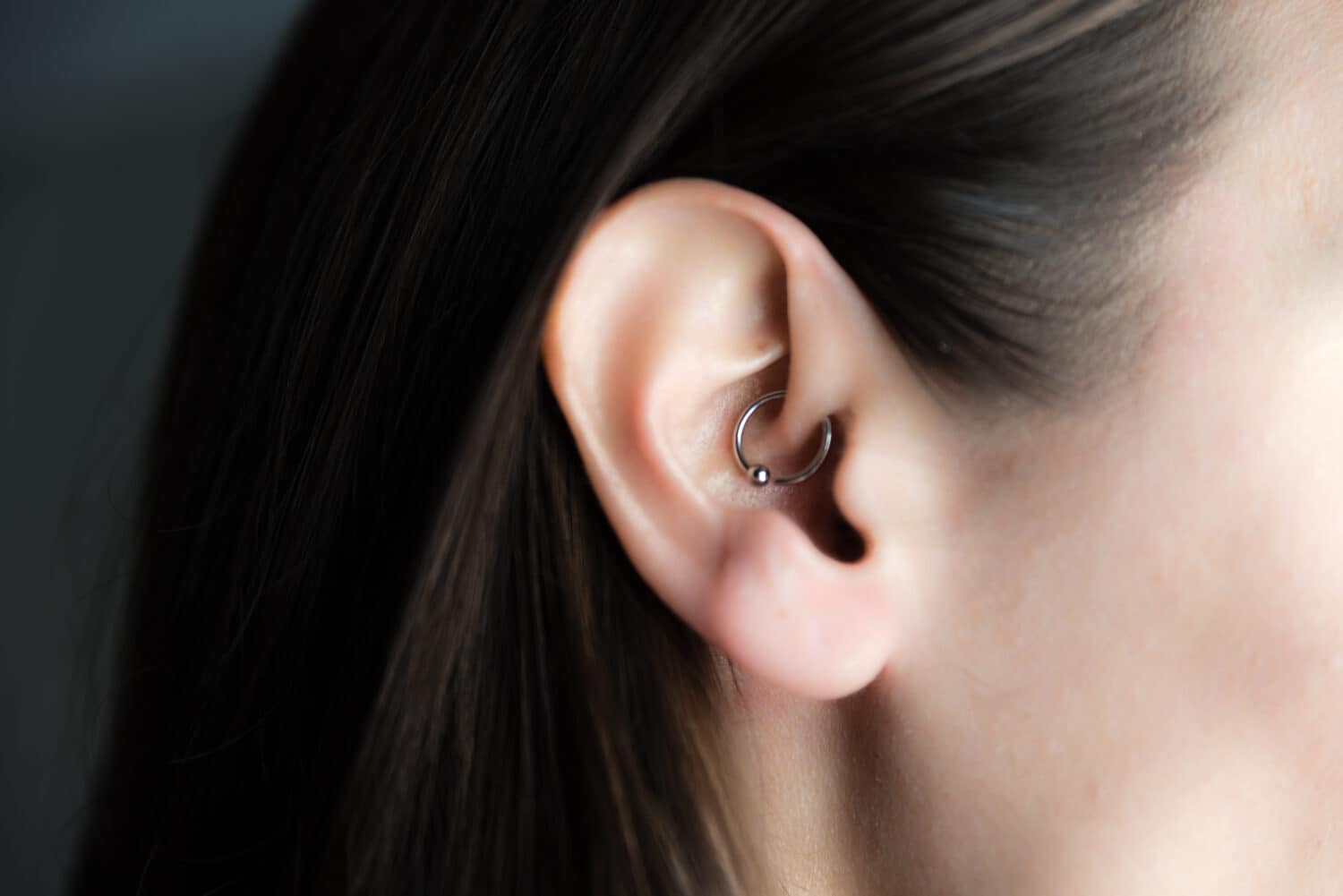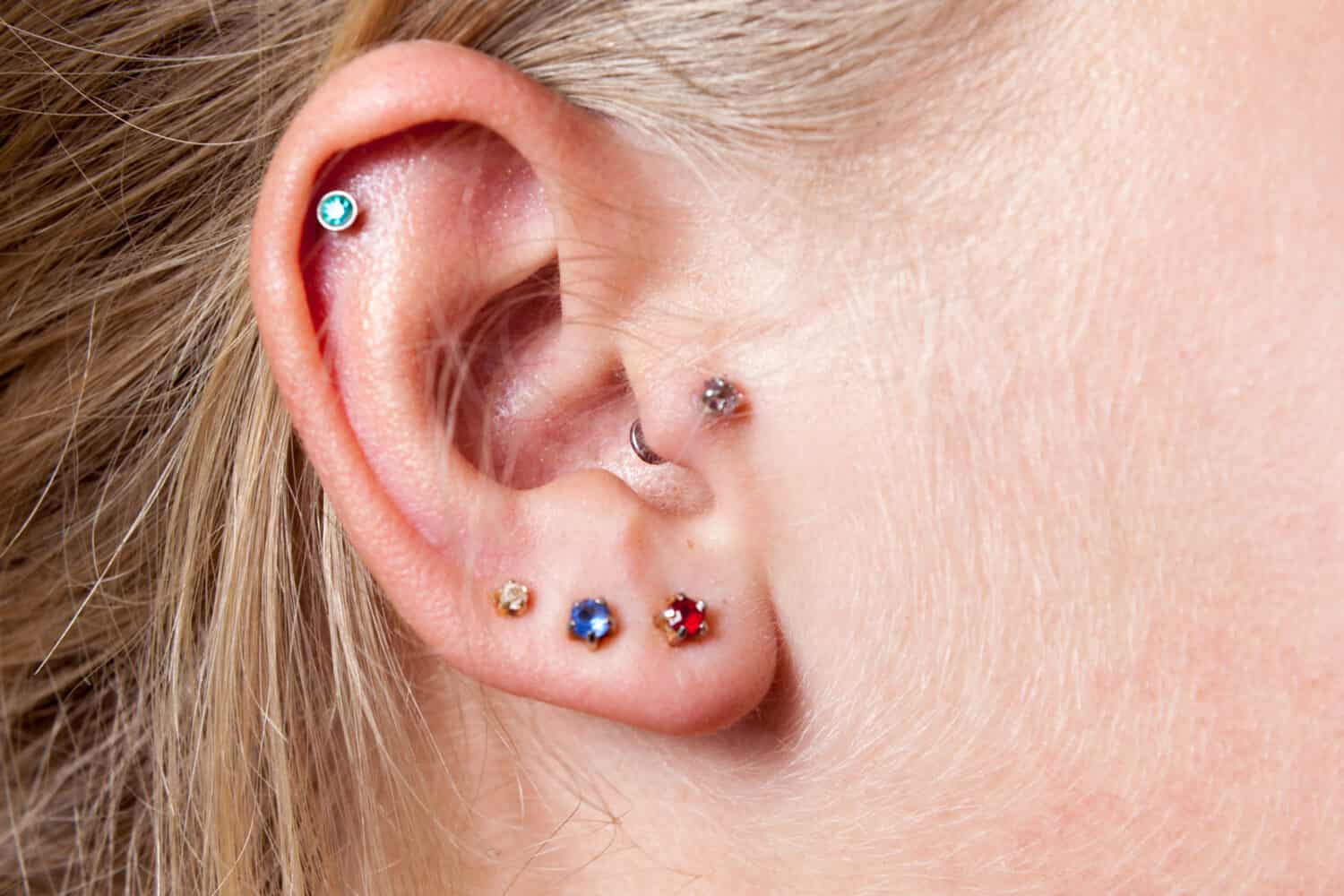When you think about ear piercings, your mind probably goes to the traditional piercing on the lobe of your ear. Or maybe you've seen women with stacked earrings or unique styles and wondered about their piercings. How did they decide what to pierce, and what's the difference between locations on the ear?
Whether you're new to ear piercing or you'd like to add an additional detail, there are several options to choose from. These options range from the traditional bottom (lobe) portion of your ear all the way to the very top with the helix piercing. Today, we'll cover 12 different locations, including what each means, the pain level involved, and the amount of healing time you can expect.
Ear Piercing Chart
As a helpful tool, we've included a comprehensive guide to visually represent each piercing location. This chart can also be used to communicate with the person piercing your ear so they better understand what you're looking for.

©MomsWhoThink / Alyssa Chavez
Lobe
The lobe piercing is many people's first choice when they decide to pierce their ears. This location is the most traditional, and because it doesn't involve piercing the cartilage of your ear, the healing time is pretty straightforward.
- The must-have convenient reference guide for every home cook!
- Includes more than 8,000 substitutions for ingredients, cookware, and techniques.
- Save time and money on by avoiding trips to grab that "missing" ingredient you don't really need.
Other options for the lobe location include the upper lobe. Many people choose to do a second or third piercing slightly above their first. This location is versatile as it lets you choose between studs, hoops, and decorative earrings.

©Vladimir Gjorgiev/Shutterstock.com
Transverse Lobe
The transverse lobe is a unique piercing that involves a barbell to be threaded through your ear lobe from side to side. This piercing is different because it doesn't do the traditional piercing from front to back. Both sides of the barbell can be seen from the edge of the lobe of your ear.
Because this location is still part of your fattier ear lobe, the pain level tends to be lower. However, remember that this piercing requires an entry and exit point. Many body piercers will use a curved needle and complete this piercing by hand.
Tragus
At the entrance to your ear canal is a small piece of cartilage. Piercing this location is called the tragus piercing. This location became popular during the 1980s, according to Byride.com. Depending on your preference, you can also wear a stud or hoop in this location.
Because this location involves piercing the cartilage of your ear, the pain level tends to be slightly higher. You can also expect a longer healing time.
Anti-Tragus
Opposite the cartilage that covers the entrance to your ear canal is another small portion of cartilage on your ear next to the lobe. Piercing this location is called an anti-tragus piercing, usually requiring a hoop or barbell instead of a stud.
This cartilage area is thicker, causing the pain level to be slightly higher than the lobe area. Healing time is similar to that of the tragus, with a couple of months to recover and anywhere from 6 to 12 months to fully heal. It's also recommended that you don't sleep on the side of this piercing at first to reduce pain and keep your jewelry from twisting.
Orbital
An orbital piercing can offer lots of variety as this type is simply two holes connected by one piece of jewelry. This type of piercing is usually done with a hoop and can sometimes be confused for the conch piercing, which we'll discuss a bit later.
Because this piercing requires two holes to be made in the cartilage of your ear, the pain level and healing time are much higher than traditional lobe piercings. However, because this option is versatile, healing time will depend on where you decide to get the piercing.
Snug
Located above the anti-tragus is a snug piercing. This option is similar to the transverse lobe in that it requires an entry and exit point. The piercing is also fully visible from the front of the ear instead of going through the back.
It's important to note, however, that not every ear is shaped to be able to do the snug piercing. You'll want to check with your piercer to determine if your ear is the right fit. Healing time and pain level are similar to other cartilage piercings, too.
- The must-have convenient reference guide for every home cook!
- Includes more than 8,000 substitutions for ingredients, cookware, and techniques.
- Save time and money on by avoiding trips to grab that "missing" ingredient you don't really need.
Conch
A conch piercing involves a piercing in either the upper or lower portion of your cartilage. Scientifically speaking, this area is called the concha. Depending on the size and shape of your ear, you can either use studs for an inner conch piercing or choose hoops for an outer conch piercing. Because a hoop is used for the outer conch, it can be easily confused with an orbital piercing.
This type of piercing is similar to the snug piercing in terms of healing and pain because it's performed in the cartilage.
Rook
The rook piercing is located in the upper section of your ear's cartilage between the inner and outer ear. This can look similar to the snug piercing as it typically involves a barbell, and the full piercing can be seen on the front of your ear. You can also choose a hoop earring to add uniqueness to this location.
Because of its location in the cartilage of your ear, the pain level can be relatively high with this piercing. It's also similar to the snug option and can require a rather lengthy healing time.
Daith
Daith piercings are also located in the upper portion of your ear and “hug” the inner cartilage. This piercing is usually seen as a small hoop earring but can also include a small ring with a bead to add a little more style and flair.
Interestingly, some have chosen this piercing with the hopes of reducing migraine pain. However, the National Library of Medicine reports that this piercing doesn't scientifically provide any migraine relief, unfortunately. When it comes to pain and healing time, daith is similar to other cartilage piercings.

©JCDH/Shutterstock.com
Industrial
The industrial piercing, with its signature barbell that stretches across the top of the ear, has grown in popularity over the years. This piercing involves two holes that are connected by way of a barbell. While this is typically performed in the upper ear, it can also be done vertically and include other portions of the ear.
Because this type requires your ear to be pierced twice instead of once, it can lead to a higher pain level. It also must be done by hand with a needle instead of a typical piercing gun. Healing time is similar to other cartilage piercings.
Helix
A helix piercing includes any piercing done on the outer upper cartilage of your ear. It's usually seen as a hoop or ring that covers the outer portion of the ear. As an additional option, some decide to get this area pierced more than once with a double or triple helix piercing. Multiple helix piercings can give you a layered look.
While this piercing is still done on the cartilage of your ear, it's a less delicate area and tends to be less painful than other cartilage piercings. The helix can also heal a bit faster.
Forward Helix
Right above the tragus and on the front-facing cartilage of your ear is the forward helix. Like the helix, you can get multiple piercings in this location to add style and uniqueness to your look. You'll typically see this piercing as layered studs.
The healing and pain level is similar to the helix, as well. However, this piercing is usually fairly easy to maintain once healed.
Final Thoughts
When it comes to ear piercings, there are several different and unique options to choose from. Depending on your style, taste, and pain level, you can get almost any area of your ear pierced. Keep in mind that all ear piercings require proper aftercare to avoid infection or irritation. You'll want to be sure to talk with your piercer about the best way to take care of whichever piercing you choose.
The image featured at the top of this post is ©Alexander_IV/Shutterstock.com.
- The must-have convenient reference guide for every home cook!
- Includes more than 8,000 substitutions for ingredients, cookware, and techniques.
- Save time and money on by avoiding trips to grab that "missing" ingredient you don't really need.

